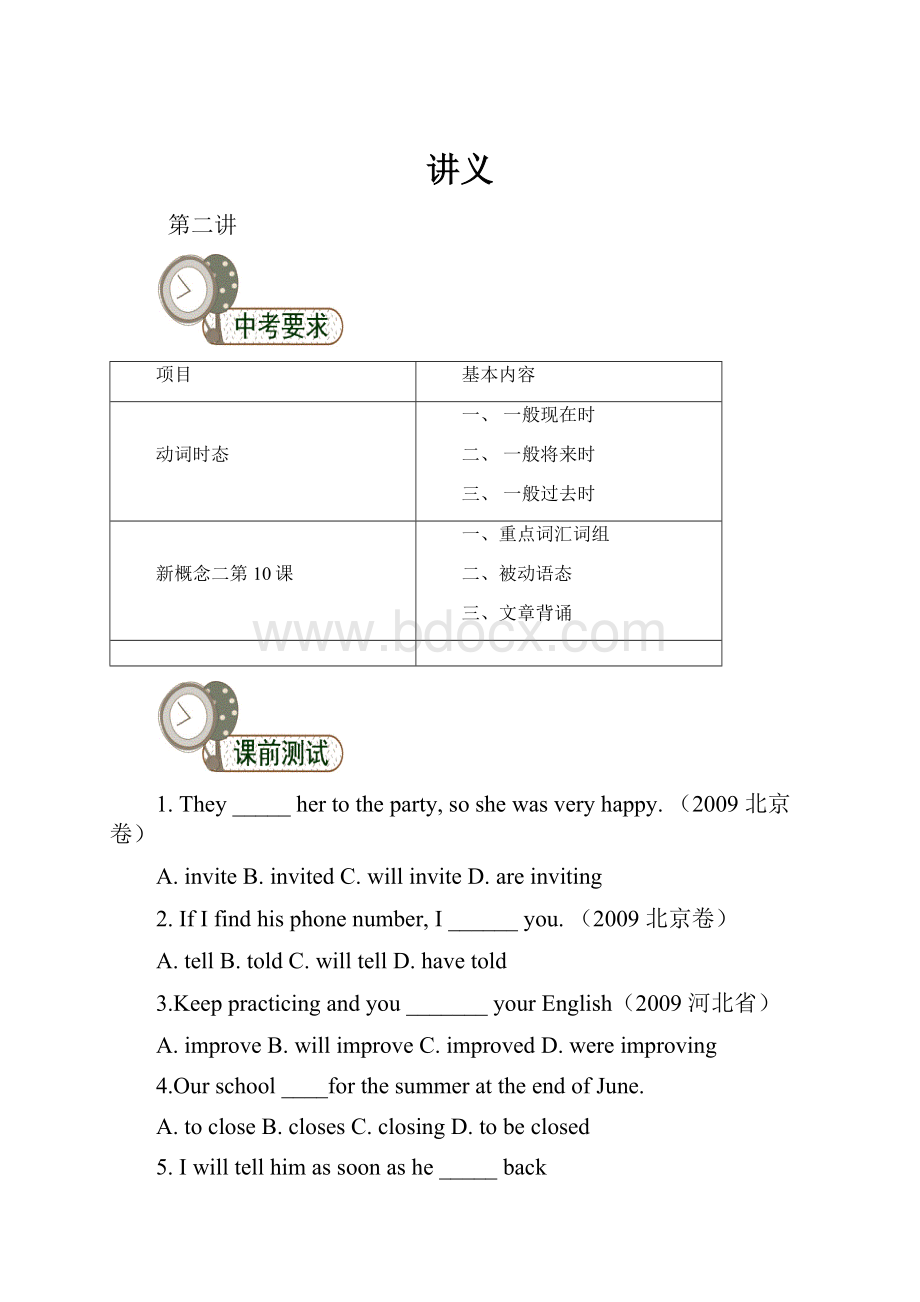讲义.docx
《讲义.docx》由会员分享,可在线阅读,更多相关《讲义.docx(38页珍藏版)》请在冰豆网上搜索。

讲义
第二讲
项目
基本内容
动词时态
一、一般现在时
二、一般将来时
三、一般过去时
新概念二第10课
一、重点词汇词组
二、被动语态
三、文章背诵
1.They_____hertotheparty,soshewasveryhappy.(2009北京卷)
A.inviteB.invitedC.willinviteD.areinviting
2.IfIfindhisphonenumber,I______you.(2009北京卷)
A.tellB.toldC.willtellD.havetold
3.Keeppracticingandyou_______yourEnglish(2009河北省)
A.improveB.willimproveC.improvedD.wereimproving
4.Ourschool____forthesummerattheendofJune.
A.tocloseB.closesC.closingD.tobeclosed
5.Iwilltellhimassoonashe_____back
A.comeB.comesC.willcomeD.came
6.Mary_____onshoeswhenshe____them.
A.tries…buysB.tries…buiesC.trys…buysD.trys…buies
7._____yourteacher____fromthemveryoften?
Certainly.
A.Do…hearB.Does…hearC.Do…receiveD.receive
8.Ihaven'tgonetoschoolsinceI_____ill.I'llgotoschoolimmediatelywhenIrecover.
A.wasB.havebeenC.amD.hadbeen
9.Thegreybuildingiswheretheworkerslive,andthewhiteoneiswherethespareparts_____.
A.areproducingB.areproducedC.producedD.beingproduced
10.Thelasthalfofthenineteenthcentury___thesteadyimprovementinthemeansoftravel.
A.haswitnessedB.waswitnessedC.witnessedD.iswitnessed
11.They_____toenterthebuildingbythebackdoor,however,thefrontdoorwaslocked.
A.weren'tsupposedB.wouldn'tbesupposedC.weresupposeD.wouldbesupposed
一般现在时
一般现在时
通常表示经常发生或习惯性的动作或目前的状态,常和always,usually,often,sometimes,everyday,inthemorning,onSundays等时间状语连用。
例如:
Iamateacher.
Theearthisround.
Theygotoschooleveryday.
Hesmokesaloteveryday.
Doyouknowhisname?
Ifitdoesn’train,we’llgotothezoo.
巧记口诀
1.一般现在时时间状语口诀
总是、经常、常常,有时、每一、没标志,星期s和周末。
◆口诀解释:
这个口诀是一般现在时的时间状语标志口诀,遇到口诀里的单词(always,often,usually,sometimes,everyday...Shecomesearly.这句没有时间的标志,onSundays,attheweekends)我们记得用一般现在时。
具体用法如下:
用法
例句
表示经常性或习惯性的动作。
Wegetupatsixeverymorning.
我们每天早上六点钟起床。
表示客观真理,客观存在,科学事实。
Theearthmovesaroundthesun.
地球绕着太阳转。
表示格言或警句中。
Pridegoesbeforeafall. 骄必败。
表示现在时刻的状态、能力、性格、个性。
Mr.WangwritesgoodEnglishbutdoesnotspeakwell.
王先生的英文写得很好但他说不好。
在时间和条件状语从句中代表一般将来时。
I'llgowithyouifyouarefreetomorrow.
如果你明天有空的话我将和你一起去。
2.一般现在时动词的结构(三单)
时态其实很简单,变化的主线就是动词,只要我们掌握了动词的变化规律就什么也不怕了。
下面我们来说说一般现在时动词的变化规则。
be动词
行为动词
用法
我是am你是are,is跟着他、她、它,复数都用are。
第三人称单数外,都用动词原形,主语是第三人称单数时,在动词词尾加-s或-es。
肯定式
Iamastudent.
ShelikesEnglish.
否定式
Iamnotastudent.
Shedoesn’tlikeEnglish.
疑问式
Areyouastudent?
DoesshelikeEnglish?
简略回答
Yes,Iam./No,I’mnot.
Yes,shedoes./No,shedoesn’t.
关于行为动词在一般现在时中,当句子的主语是第三人称单数时,具体变化规律如下:
情况
构成规则
举例
一般的动词
在词尾加–s
live→lives,eat→eats
以字母s,x,sh,ch和o结尾的动词
在词尾加–es
go→goes
以“辅音字母+字母y”结尾的动词
改词尾的y为–ies
carry→carries,worry→worries
特殊变化
没有统一的规则
have→has
巧记口诀
一般现在时用法及句型转换口诀
经常习惯动作和真理,是一般现在时的定义,构成除单三皆动原式。
若逢动词第三人称体,动词变单三式有道理。
若要变成否定的形式,动词原形之前加don’t,除单三人称外无特例。
单三式前doesn’t加,单三式变动原基。
句首Do,Does疑问起,Does用单三人称限制,单三还原形没问题。
写出下列动词的第三人称单数形式。
1.workreadcleanwrite
2.teachwashguesswatch
3.dohavearegive
4.studyflycrycatch
5.meetthinkwinplay
一、用动词be的适当形式填空。
1.Theresomemagazinesonthetable.
2.Theynotdoctors,theyteachers.
3.HisnameJohn.HeaMiddleschoolstudent.HefromAmerica.
4.Whatinyourbag?
theresomefoodinit?
5.Look,whooverthere?
ItJack.
二、改错。
1.IsyourbrotherspeakEnglish?
2.Doeshelikesgoingfishing?
3.Helikesplaygamesafterclass.
4.Mr.WuteachsusEnglish.
一般将来时
一般将来时
一般将来时由shall/will+动词原形构成,表示将要发生的动作或存在的状态以及计划、打算做某事。
常与一些表示将来的时间状语连用,如:
tomorrow(明天),nextweek(下周),fromnowon(从现在开始);inthefuture(将来)等。
如:
I(We)shallbebacktomorrow.我(我们)明天回来。
He’llcomebacknextweek.他下周回来。
一般将来时的其他用法
一般将来时表示将来某一时刻的动作或状态,其表达形式除了“shall(第一人称),will(第二、三人称)+动词原形构成”外,还有以下几种形式。
1)“begoingto+动词原形”表示即将发生的或最近打算进行的事。
如:
Itisgoingtorain.要下雨了。
Wearegoingtohaveameetingtoday.今天我们开会。
2)某些词,如come,go,leave,arrive,start,get,stay等的一般现在时也可表示将来。
如:
Themeetingstartsatfiveo'clock.会议五点开始。
Hegetsoffatthenextstop.他下一站下车。
3)go,come,start,move,sail,leave,arrive,stay等可用进行时态表示按计划即将发生的动作。
如:
I'mleavingforBeijing.我要去北京。
用所给动词的适当形式填空。
1.Iwon’t(be)freetomorrow.
2.Lily(stay)withmetonight.
3.It’sgoingto(rain)thisevening.
4.We(visit)ourteachernextSunday.
5.She(come)heresoon.
一、单项选择。
1.He________verybusythisweek,he________freenextweek.
A.willbe;isB.is;isC.willbe;willbeD.is;willbe
2.He________thereattentomorrowmorning.
A.willB.isC.willbeD.be
3.________yourbrother________amagazinefromthelibrary?
A.Are;goingtoborrowB.Is;goingtoborrow
C.Will;borrowsD.Are;goingtoborrows
4.--ShallIbuyacupofteaforyou?
--________.(不,不要。
)
A.No,youwon’t.B.No,youaren’t.C.No,pleasedon’t.D.No,thanks.
5.Iftheycome,we________ameeting.
A.haveB.willhaveC.hadD.wouldhave
二、句型转换。
1.Peopleinthenorthoftengoskatinginwinter.(nextwinter)
2.Therearetwocinemasinthattown.(nextyear)
3.Hecomesbacklate.(intwodays)
4.Sheisaconductorofatrain.(soon)
5.Iamnotfreenow.(tomorrow)
一般过去时
一般过去时
一般过去时表示过去发生的动作或存在的状态。
1.一般过去时的构成:
主语+动词过去式+其它。
如:
Theyhadagoodtimeyesterday.
2.一般过去时常用的时间状语
amomentago(刚才),yesterdaymorning,lastnight/week,thedaybeforeyesterday(前天),justnow(刚才)等。
3.动词过去式的变化规律
1)动词过去式的变化可速记为“直”、“去”、“双”、“改”四字诀。
①一般情况下在动词原形后直接加-ed。
如:
want→wantedplay→played
②以不发音的字母e结尾的动词,去掉e再加-ed。
如:
hope→hopedlive→lived
③重读闭音节单词需双写最后一个辅音字母再加-ed。
如:
stop→stopped
④以辅音字母+y结尾的动词变y为i,再加-ed。
如:
study→studiedworry→worried
◆规则动词过去式的读音也有规律可循。
请记住:
清后[t],元浊[d],[t][d]之后读[id]。
①清辅音[p][k][ʃ][s]等后,ed要读[t]。
如:
workedfinished
②元音或浊辅音[b][g][v][z][m]等后,ed要读[d]。
如:
livedcalled
③[t]或[d]后,ed读[id]。
如:
startedneeded
2)不规则动词变化,要逐一熟记。
be动词过去式有两种形式,主语是第一、三人称单数形式使用was,其他人称用were。
不规则动词时态变化表
变化类型
Example
A---A---A型
(现在式、过去式和过去分词同形)
costcostcost花费
cutcutcut割,切
hithithit打
letletlet让
putputput放下
readreadread读
hurthurthurt伤
A---A---B型(现在式和过去式同形)
beatbeatbeaten打
A---B---A型
(现在式和过去分词同形)
comecamecome来
becomebecamebecome变
runranrun跑
A---B---B型
(过去式和过去分词同形)
(1)词原形后加一个辅音字母d或t构成过去式或过去分词
burnburntburnt燃烧
learnlearned/learntlearned/learnt学习
meanmeantmeant意思是
hearheardheard听见
(2)词原形的最后一个辅音字母“d”改为“t”构成过去式或过去分词
buildbuiltbuilt建筑
lendlentlent借给
loselostlost失去
sendsentsent送
spendspentspent花费
(3)其他
paypaidpaid付
laylaidlaid下蛋
saysaidsaid说
bringbroughtbrought带来
buyboughtbought买
thinkthoughtthought想
sleepsleptslept睡
keepkeptkept保持
sweepsweptswept扫
standstoodstood站
understandunderstoodunderstood明白
winwonwon得胜
catchcaughtcaught抓住
teachtaughttaught教
feelfeltfelt觉得
fightfoughtfought战斗
findfoundfound发现
getgotgot得到
hanghanged/hunghanged/hung绞死,挂
havehadhad有
holdheldheld盛,握
leaveleftleft离开
makemademade制造
meetmetmet遇见
sellsoldsold卖
telltoldtold告诉
smellsmelt/smelledsmelt/smelled嗅,闻
sitsatsat坐
flyflewflown飞
A---B---C型
(现在式、过去式和过去分词都不同)
(1)动词原形后加-n或-en构成过去分词。
eatateeaten吃
fallfellfallen落下
givegavegiven给
taketooktaken拿
seesawseen看见
writewrotewritten写
rideroderidden骑
drivedrovedriven驾驶
throwthrewthrown抛,扔
blowblewblown吹
growgrewgrown生长
knowknewknown知道
drawdrewdrawn拉,绘画
showshowedshown展示
(2)过去式加-n或-en构成过去分词。
speakspokespoken说话
breakbrokebroken破碎,折断
stealstolestolen偷
freezefrozefrozen冻结
wakewaked/wokewaked/waken醒
choosechosechosen选择
forgetforgotforgotten忘记
(3)变单词在重读音节中的元音字母“i”分别为“a”(过去式)和“u”(过去分词)
beginbeganbegun开始
ringrangrung按铃
singsangsung唱
swimswamswum游泳
drinkdrankdrunk饮
(4)其他不规则动词的变化
be(am,is)was/werebeen是
be(are)werebeen是
dodiddone做
gowentgone去
lielaylain躺
wearworeworn穿
一、写出下列动词的过去式。
1.comeflyplantare
2.play gomaketake
3.drinkdanceworrycarry
4.tasteeatdrawput
5.throwkickpass do
二、Be动词的过去式练习。
1.I______adoctorfiveyearsago.
2.She_______verysadyesterday.
3.They_______verytiredatthistimeyesterdayevening.
4.LucyandJohn________lateforschoolthismorning.
5.Thereaverybigtreeherebefore.
用所给动词的适当形式填空。
1.They(go)totheparklastSunday.
2.Hisfather(get)aletterfromhissisterlastweek.
3.Who(break)thewindowjustnow?
4.---he(do)hishomeworkyesterday?
---No,he(do).
5.Shestill(have)timetocookforyouatthattimeyesterday.
4.一般过去时的用法:
一般过去时的基本用法
1)表示过去某个特定时间发生的动作或存在的状态。
如:
Hesuddenlyfellillyesterday.昨天他突然生病了。
Theenginestoppedbecausethefuelwasusedup.发动机因燃料用光而停机了。
2)表示过去经常发生的动作或存在的状态。
如:
Iwrotehomeonceaweekatcollege.我上大学时每周给家里写一封信。
Hewasalreadyinthehabitofreadingwidelyinhisboyhood.
他童年时就养成了广泛阅读的习惯。
◆注:
表示过去的习惯性动作,除了用过去时外,还可以用usedto或would来表示。
如:
SheusedtostudylateintothenightwhenshewasinSeniorThree.她上高三时经常学习到深夜。
Hewouldsitforhoursdoingnothing.过去他常常一坐几个钟头什么事也不做。
3)表示过去连续发生的一系列动作。
如:
Sheenteredtheroom,pickedupamagazineandlookedthroughitcarefully.
她走进房间,拿起一本杂志,认真地翻阅了起来。
Thestudentsgotupearlyinthemorning,didmorningexercisesandthenreadEnglishaloudintheopenair.学生们很早起床,做